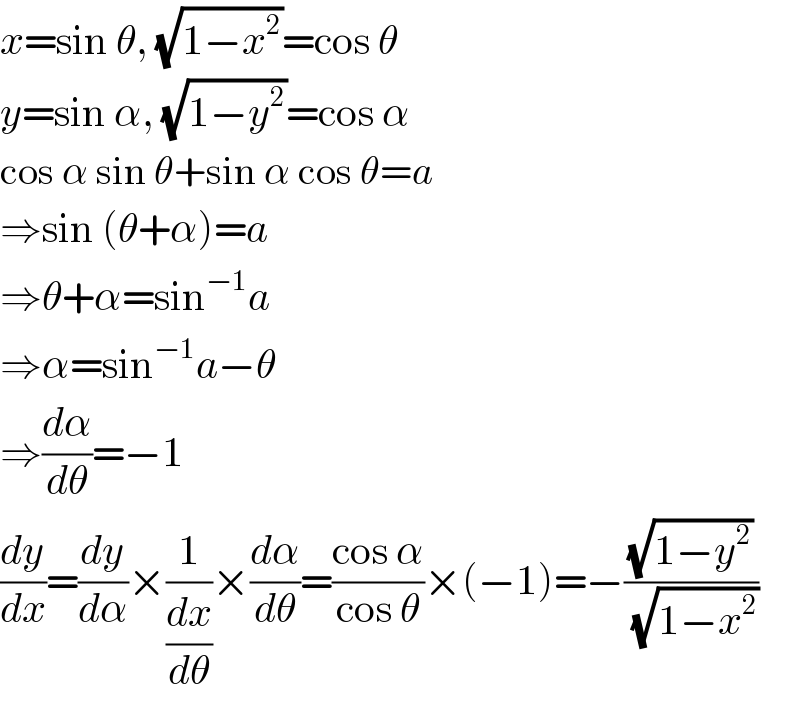Question Number 26446 by yesaditya22@gmail.com last updated on 25/Dec/17

Answered by ajfour last updated on 25/Dec/17

$$\mathrm{cos}\:\theta\mathrm{sin}\:\theta+\mathrm{sin}\:\theta\mathrm{cos}\:\theta={a} \\ $$$$\Rightarrow\:\mathrm{sin}\:\mathrm{2}\theta={a} \\ $$$$\frac{{d}\left(\mathrm{sin}\:\theta\right)}{{d}\left(\mathrm{cos}\:\theta\right)}=\frac{\mathrm{cos}\:\theta}{−\mathrm{sin}\:\theta}\:=−\sqrt{\frac{\mathrm{1}−{y}^{\mathrm{2}} }{\mathrm{1}−{x}^{\mathrm{2}} }}\:. \\ $$
Commented by mrW1 last updated on 26/Dec/17

$${x}=\mathrm{sin}\:\theta,\:\sqrt{\mathrm{1}−{x}^{\mathrm{2}} }=\mathrm{cos}\:\theta \\ $$$${y}=\mathrm{sin}\:\alpha,\:\sqrt{\mathrm{1}−{y}^{\mathrm{2}} }=\mathrm{cos}\:\alpha \\ $$$$\mathrm{cos}\:\alpha\:\mathrm{sin}\:\theta+\mathrm{sin}\:\alpha\:\mathrm{cos}\:\theta={a} \\ $$$$\Rightarrow\mathrm{sin}\:\left(\theta+\alpha\right)={a} \\ $$$$\Rightarrow\theta+\alpha=\mathrm{sin}^{−\mathrm{1}} {a} \\ $$$$\Rightarrow\alpha=\mathrm{sin}^{−\mathrm{1}} {a}−\theta \\ $$$$\Rightarrow\frac{{d}\alpha}{{d}\theta}=−\mathrm{1} \\ $$$$\frac{{dy}}{{dx}}=\frac{{dy}}{{d}\alpha}×\frac{\mathrm{1}}{\frac{{dx}}{{d}\theta}}×\frac{{d}\alpha}{{d}\theta}=\frac{\mathrm{cos}\:\alpha}{\mathrm{cos}\:\theta}×\left(−\mathrm{1}\right)=−\frac{\sqrt{\mathrm{1}−{y}^{\mathrm{2}} }}{\:\sqrt{\mathrm{1}−{x}^{\mathrm{2}} }} \\ $$
